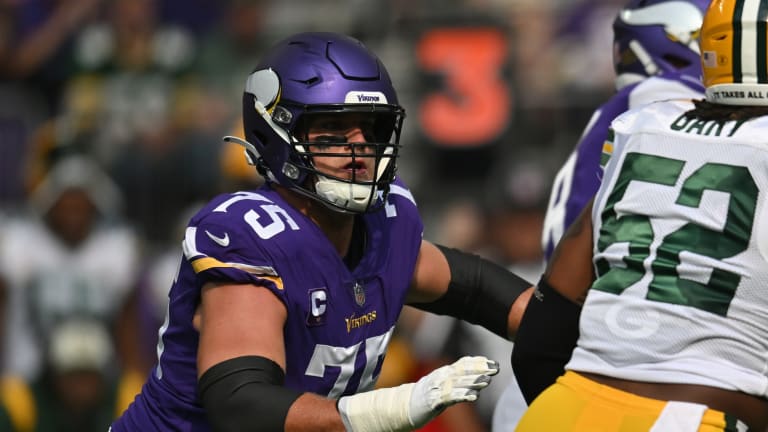
The 'oh s---' moments that separate Vikings tackle Brian O'Neill

EAGAN — With 1:06 remaining in the game and the Minnesota Vikings trailing the Detroit Lions by a field goal, Brian O’Neill got beat.
Lined up far outside the tackle, Detroit rusher Julian Okwara had several steps to build momentum before making contact with the right tackle. With running back Alexander Mattison leaving the backfield on a passing route, O’Neill was alone in space with the young defender, who had 5.0 sacks last season. Okwara pushed O’Neill back with his initial rush and then swiped the tackle’s hands away to create separation.
At that moment Kirk Cousins had just settled into his spot in the pocket and his eyes were on receiver KJ Osborn streaking across the middle of the field. His body was angled to the left preparing a throw that would lead Osborn to the spot. He was so focused downfield that a bus could have been coming at Cousins and he wouldn’t have seen it.
As the veteran QB raised his arm to throw, Okwara was completely past O’Neill. Both nines on his jersey were facing Cousins. But at the last possible second, the Pro Bowl tackle spun around and got a hand on Okwara’s right shoulder, nudging him one yard too far to reach Cousins. The pass hit Osborn on the money, moving the ball to the Detroit 28-yard line. From there, Cousins found Osborn again for a game-winning touchdown pass.
Over his five-year career, O’Neill has made recovering against successful pass rushes into an art form. He’s only allowed seven sacks in 2,530 pass blocking plays, per Pro Football Focus — and maybe even more remarkably, only 20 QB hits.
“He’s got a lot of tools physically that make him a special player,” head coach Kevin O’Connell said of O’Neill. “But then it’s that strain to finish. We talk a lot about straining to finish.”
Inside the offensive line room, plays like O’Neill’s block against Okwara are lauded. There may be a correction to be made on the initial pass set, or what happened with the hands, but it’s a bottom-line business for the fellas up front.
“[Offensive line] coach Kuper always talks about having a ‘pro pocket,’ it’s not always going to look perfect,” center Garrett Bradbury said. “If we’re straining and fighting and making sure we can give Kirk that one more hitch or one more half second he can make good things happen with the ball. It’s just fighting through the down.”
In a league where pocket quarterbacks are asked to throw the ball within 2.5 seconds of taking the snap, the ability to provide even a few extra tenths of a second for the QB can be the difference between an average and great offensive lineman. But how does one become good at reacting to things at lightning speed in moments of panic?
“I would say it’s, ‘find a way,’ more than technical,” O’Neill said on Wednesday. “It’s just like, ‘Oh s— here we go.’”
Within the find-a-way mentality there has to be technique, otherwise linemen would end up getting too grabby and draw flags or simply whiff and make things worse.
“I feel like you have to have the right hand placement to pull yourself back on [the rusher] but it’s also a feel thing, feel and effort,” center Austin Schlottmann said. “Inside hands and moving your feet avoids a lot of holding penalties.”
“You can’t stop your feet,” O’Neill said. “Stopping your feet is the worst thing you can do. If you can run your feet through the end of the play you have a chance.”
O’Neill’s quickness always gives him a chance to recover considering he ran a 4.82 40-yard dash at the 2018 NFL Combine, which is in the 98th percentile for offensive tackles (per Mockdraftable). But he also needs aiming points for a final swing at the defender.
“You try to understand the best angle of where to hit him on his body to try to ride his hip because if you can get his hip he will usually be displaced a little bit more,” O’Neill said. “Sometimes you have to dive off the back of the pocket, sometimes you have to turn and run. A lot of it is just being able to play it a couple steps longer than you think.”
The natural question is how someone goes about practicing getting beat. It would be like working on getting crossed over in basketball. Linemen put their focus into mastering techniques, understanding the details of every play and studying opponents but they also have to factor recovering from effective pass rushes into practice.
“I would say practice being in difficult situations,” guard Ezra Cleveland said.
O’Neill has certainly had the benefit of difficult practices having gone against star edge rusher Danielle Hunter since Day 1 of his career.
No matter how it goes done, it has to be done. And the Vikings’ offensive line has been effective so far this season doing it. Only 9.1% of pressures on Cousins have turned into sacks, per PFF, which is the fourth lowest in the NFL. They’ll need to keep finding a way for that to continue.
“It might be that last touch that allows Kirk to climb the pocket… if you can give [Kirk] maybe one or two hitches to see downfield as we try to manipulate things for him, he’s gonna turn it loose,” O’Connell said.








